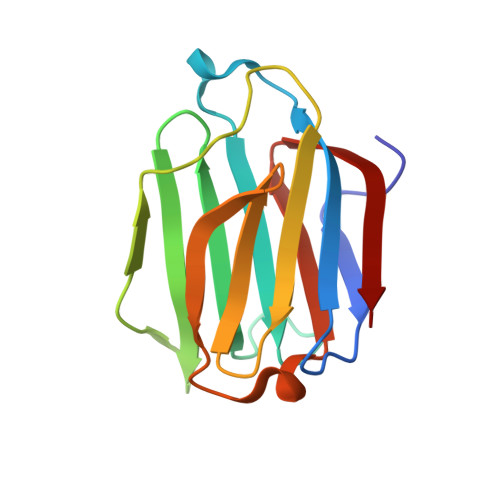Resetting the ligand binding site of placental protein 13/galectin-13 recovers its ability to bind lactose
Su, J., Cui, L., Si, Y., Song, C., Li, Y., Yang, T., Wang, H., Mayo, K.H., Tai, G., Zhou, Y.(2018) Biosci Rep 38
- PubMed: 30413611
- DOI: https://doi.org/10.1042/BSR20181787
- Primary Citation of Related Structures:
6A62, 6A63, 6A64, 6A65, 6A66 - PubMed Abstract:
Placental protein 13/galectin-13 (Gal-13) is highly expressed in placenta, where its lower expression is related to pre-eclampsia. Recently, the crystal structures of wild-type Gal-13 and its variant R53H at high resolution were solved. The crystallographic and biochemical results showed that Gal-13 and R53H could not bind lactose. Here, we used site-directed mutagenesis to re-engineer the ligand binding site of wild-type Gal-13, so that it could bind lactose. Of six newly engineered mutants, we were able to solve the crystal structures of four of them. Three variants (R53HH57R, R53HH57RD33G and R53HR55NH57RD33G had the same two mutations (R53 to H, and H57 to R) and were able to bind lactose in the crystal, indicating that these mutations were sufficient for recovering the ability of Gal-13 to bind lactose. Moreover, the structures of R53H and R53HR55N show that these variants could co-crystallize with a molecule of Tris. Surprisingly, although these variants, as well as wild-type Gal-13, could all induce hemagglutination, high concentrations of lactose could not inhibit agglutination, nor could they bind to lactose-modified Sepharose 6b beads. Overall, our results indicate that Gal-3 is not a normal galectin, which could not bind to β-galactosides. Lastly, the distribution of EGFP-tagged wild-type Gal-13 and its variants in HeLa cells showed that they are concentrated in the nucleus and could be co-localized within filamentary materials, possibly actin.
Organizational Affiliation:
Jilin Province Key Laboratory for Chemistry and Biology of Natural Drugs in Changbai Mountain, School of Life Sciences, Northeast Normal University, Changchun 130024, China sujy100@nenu.edu.cn zhouyf383@nenu.edu.cn.
















